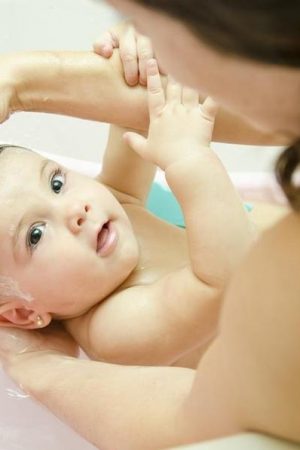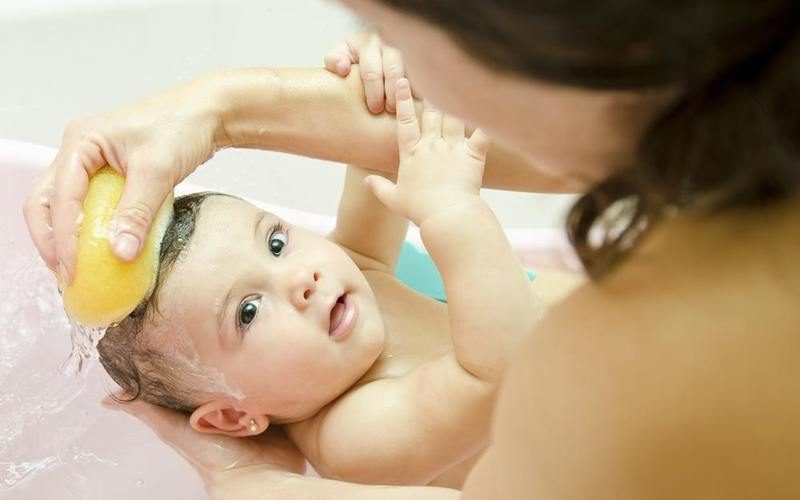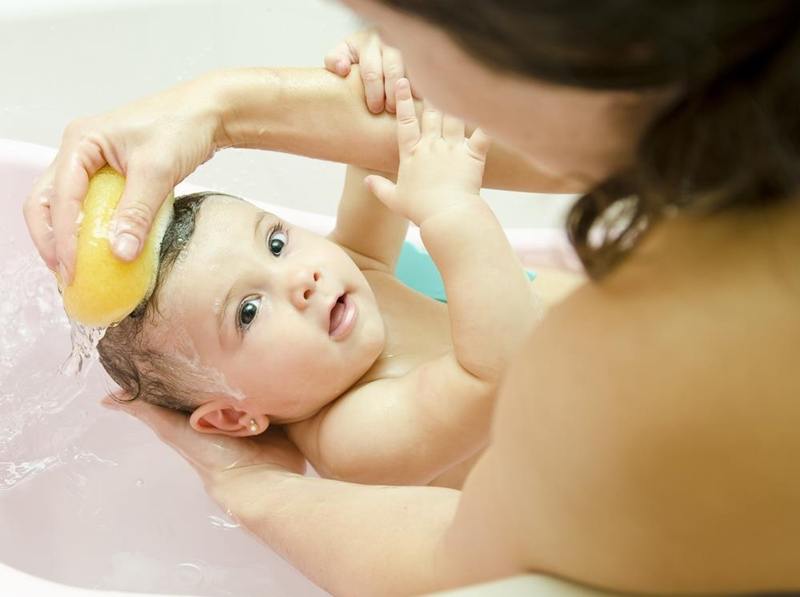When Can My Newborn Have Her First Bath?
If your baby is full-term and healthy, you can give your newborn her first bath as soon as you like. It’s best to wait at least an hour after the birth, and to keep the first bath short, no more than five minutes to 10 minutes.
You don’t need to wait for your baby’s umbilical cord stump to dry up and fall off, or for it to heal. A bath won’t make an infection in the stump more likely, and it won’t slow down the healing process. Make sure you allow it to dry off properly afterwards, though.
How Often to Bathe Your Baby
Most healthcare professionals recommend bathing newborns 2 or 3 times per week, increasing the frequency as your baby gets older. You may prefer to wash their face, neck, hands and bottom carefully instead. This is often called “topping and tailing”.
Is A Sponge Bath Good Enough?
The American Academy of Pediatrics recommends sponge baths until the umbilical cord stump falls off — which might take a week or two. To give your baby a sponge bath, you’ll need:
- A warm place with a flat surface. A bathroom or kitchen counter, changing table, or firm bed will work. Even a blanket or towel on the floor is OK. Pad hard surfaces with a blanket or towel.
- A soft blanket, towel or changing pad. Spread it out for your baby to lie on.
- A free hand. Always keep one hand on your baby. On a changing table, use the safety strap as well.
- A sink or shallow plastic basin to hold the water. Run warm water into the basin or sink. Check the water temperature with your hand to make sure it’s not too hot.
- Essential supplies. Gather a washcloth, a towel — preferably with a built-in hood — mild baby shampoo, mild moisturizing soap, baby wipes, a clean diaper and a change of clothes.
Choose a time when your baby is awake and content. Make sure the room is warm. Get everything ready beforehand. You’ll need a bowl of warm water, a towel, cotton wool, a fresh nappy and, if necessary, clean clothes.
Where to Bathe Your Baby
It makes sense to use the kitchen sink or a small plastic baby tub. A standard bathtub requires you to kneel or lean awkwardly over your baby and gives you less control over his movements.
What Type of Baby Tub Is Best?
Once your baby is ready for a bath, you might use a plastic tub or the sink. Line the tub or sink with a clean towel. Gather the supplies you’d use for a sponge bath, a cup of rinsing water and baby shampoo, if needed, ahead of time. This will allow you to keep one hand on the baby at all times. Never leave your baby alone in the water.
How Much Water Should I Put In The Tub?
A common recommendation is 2 inches (about 5 centimeters) of warm — not hot — water. To keep your baby warm, you can pour warm water over his or her body throughout the bath. Some research suggests that using slightly more water — enough to cover a baby’s shoulders — can be calming and help reduce heat loss. With any amount of water, be sure to hold your baby securely during the bath.
What’s The Best Way To Hold My Newborn In The Tub?
A secure hold will help your baby feel comfortable — and stay safe — in the tub. Use your nondominant arm to support your baby’s head and neck and the other to hold and guide your baby’s body into the water, feet first. Continue supporting your baby’s head and back as needed. You might reach behind your baby and hold on to his or her opposite arm throughout the bath.
What about Water Temperature?
Warm water is best. To prevent scalding, set the thermostat on your water heater to below 120 F (49 C). Always check the water temperature with your hand before bathing your baby. Aim for bath water around 100 F (38 C). Be sure the room is comfortably warm, too. A wet baby can be easily chilled.
How to Bathe a Newborn Baby
- Get everything ready in advance. Once the baby’s in the bath, you won’t be able to leave him or her for even a moment, so it’s important to set out everything you need before you begin. Gather all necessary bath supplies, and lay out a towel, a clean diaper, and clothes. Make sure the room is comfortably warm so your baby doesn’t get chilled.
- Set up the tub. Most baby tubs available are shaped so as to support the infant’s neck and head. They usually have a mat or sling that prevents the baby from being completely submerged in water. Place the baby tub in a clean sink, bathtub, or on the bathroom floor, depending on the manufacturer’s instructions.
- Fill the tub with about 3 inches of water that feels warm but not hot to the inside of your wrist – about 90 degrees Fahrenheit (32 degrees Celsius) or a few degrees warmer. The water should be comfortably warm to the touch, but not as hot as you’d prefer for your own bath or shower.
- Bring your baby to the bath area and undress her completely.
- Lay your baby in the tub feet first. Gradually slip your baby into the tub feet first, using one hand to support her neck and head. Pour cupfuls of bath water over her regularly during the bath so she doesn’t get cold.
- Wash her with your hand or a washcloth from top to bottom, front and back. Use a soft washcloth to gently wash the baby’s face, body, arms and legs.
- Wash the hair. If it is necessary to wash the baby’s hair, lean him or her back and gently massage water into the hair and scalp. Use the cup to pour clean water over the baby’s head. You can use baby shampoo if desired, but there is really no need. Babies are born with all the natural oils needed to keep the scalp healthy, and shampoos can easily spoil this balance.
- Lift the baby from the tub. Support the baby’s head, neck, and back with one arm, and hold his or her bottom and thigh with the other. Wrap your baby in a hooded towel and pat her dry. If her skin is dry, or if she has a bit of diaper rash, you may want to apply a mild lotion after her bath.
Cutting Your Baby’s Nails
Some babies are born with long nails and it’s important to cut them in case they scratch themselves. You can buy special baby nail clippers or small, round-ended safety scissors. If you find the idea of cutting your baby’s nails too nerve-racking, you could try filing them down with a fine emery board instead.
Topping and Tailing Tips
You may find the following step-by-step guide to washing your baby useful:
- Hold your baby on your knee or lay them on a changing mat. Take off all their clothes, apart from their vest and nappy, and wrap them in a towel.
- Dip the cotton wool in the water (make sure it doesn’t get too wet) and wipe gently around your baby’s eyes from the nose outward, using a fresh piece of cotton wool for each eye. This is so that you don’t transfer any stickiness or infection from one eye to another.
- Use a fresh piece of cotton wool to clean around your baby’s ears, but not inside them. Never use cotton buds to clean inside your baby’s ears. Wash the rest of your baby’s face, neck and hands in the same way and dry them gently with the towel.
- Take off the nappy and wash your baby’s bottom and genital area with fresh cotton wool and warm water. Dry very carefully, including between the skin folds, and put on a clean nappy.
It will help your baby to relax if you keep talking while you wash them. The more they hear your voice, the more they’ll get used to listening to you and start to understand what you’re saying.



